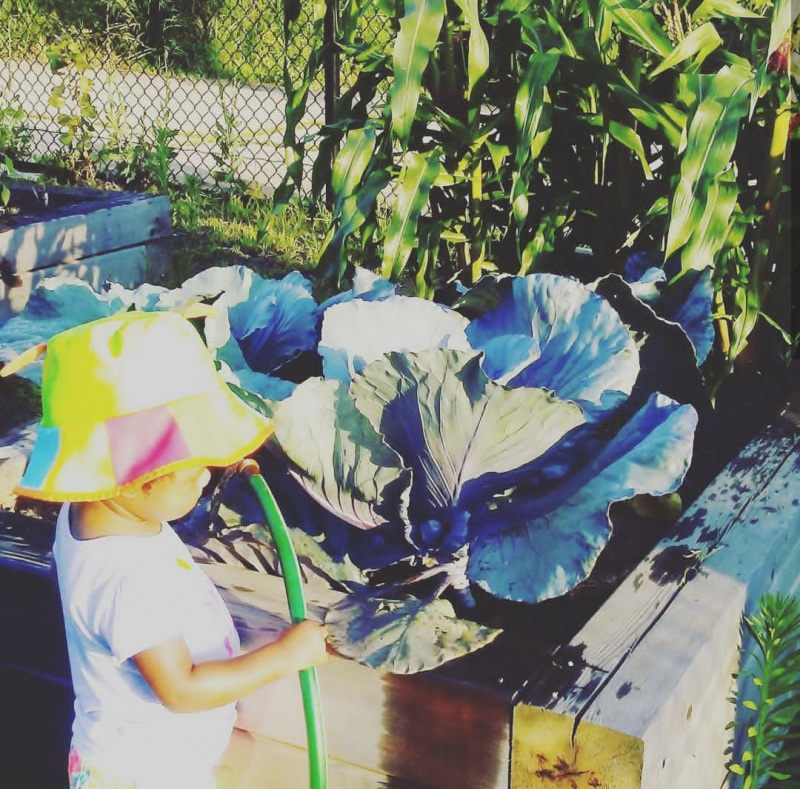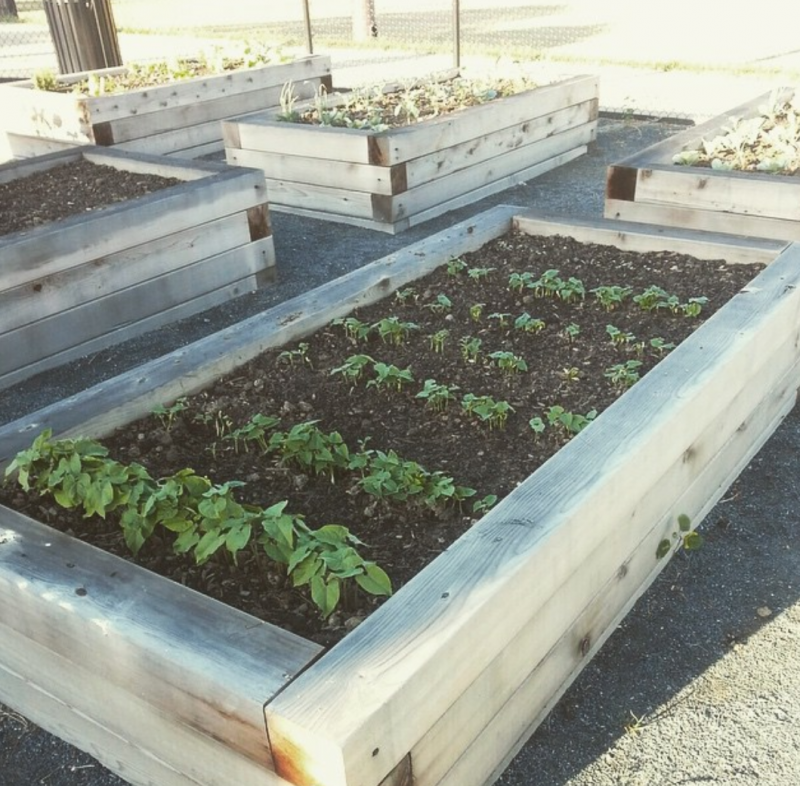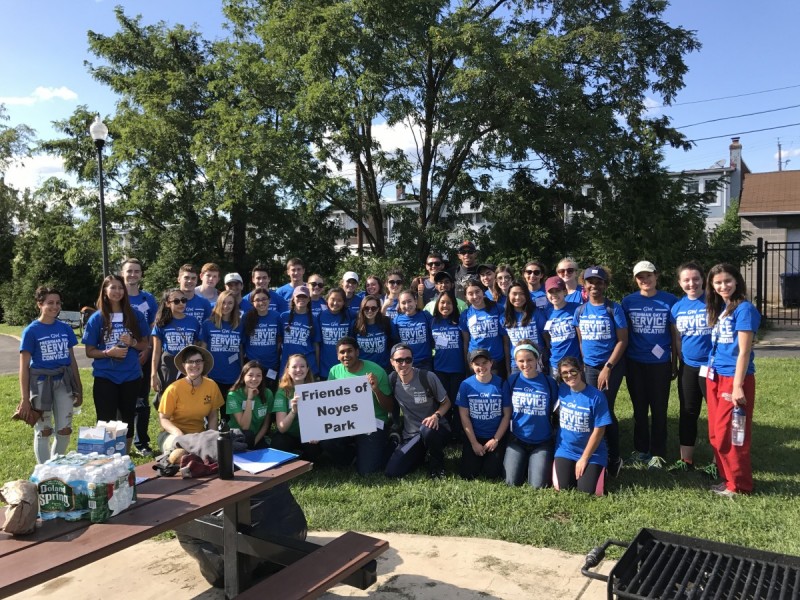Meet two of the driving forces behind urban gardening in DC

Ashleigh Taylor's daughter watering veggies at Ferebee Hope. Image by Ashleigh Taylor.
When most people think about DC, farming is probably not the first thing that comes to mind — nonetheless, urban agriculture is thriving in DC and throughout the region. To learn more about local efforts, I spoke with the coordinators of two DC gardens, Noyes Park Community Garden and Ferebee Hope Community Garden. While I'm already a fan of urban agriculture, I was genuinely surprised by their level of dedication.
Too often, gardening is waved away as a niche activity with dismissive ‘drop in the bucket’ argument. Though urban gardening will likely never replace traditional agriculture, the impacts of those patches of produce extend far beyond the vitamins and calories they generate.
Urban agriculture plots are literal laboratories. Like their medical and biochemical counterparts, they allow children to build long-term organization skills and to see the workings of genetics, environmental science, and the ethics of today’s food system.
Spurred largely by personal dedication and facilitated by salvaged hours, both garden coordinators clearly do this work because they love it. It’s a shame not to build on their efforts.
Noyes Park Community Garden during a recent garden clean-up attended by George Washington University students. Image by Becky Schwartz. 
Urban agriculture is helping the District grow
Not counting the gardening and cultivation taking place throughout the backyards, front porches, and windowsills of DC, there are hundreds of official and unofficial spaces for urban agriculture within DC’s city limits. That’s a substantial number for a city that just topped 700,000 residents for the first time in years.
The benefits that urban agriculture provides to cities are well-documented. Urban gardens help diversify diets and improve the nutrition of people living in neighborhoods with limited access to high-quality unprocessed foods. They also help develop communal bonds, and often integrate beautifully into existing structures. One of the first things a tourist does in a foreign country is sample the local cuisine, and the same gastronomical curiosity drives people’s connections to their ancestral grub. Urban agriculture at any scale can facilitate these connections.
More exciting than the number of gardens is their diversity: Washington’s urban agriculture spaces range from 12- and 20-plot gardens like Ferebee Hope or Noyes Park Community Garden (respectively) to Common Good City Farm (CGCF), which has provided “over 10 tons of fresh produce” to the city’s residents since 2007.
Much of this breadth can be attributed to the efforts of a relatively small but mighty cohort of volunteer gardening enthusiasts. I had the pleasure of speaking with two of Washington’s resident urban gardening badasses: Becky Schwartz of Noyes Park Community Garden in Brookland, and Ashleigh Taylor of the garden at Ferebee Hope in Washington Highlands, just south of the Congress Heights Metro stop. Both leaders have big goals for the future of their projects.
String beans in a planter at Ferebee Hope Community Garden. Image by Ashleigh Taylor. 
Urban gardens bring fresh vegetables where there are few grocery stores
Originally from Bowie, Maryland, Taylor has been living in Ward 8 in Southeast since 2007. She and a few other Ward 8 residents kickstarted Ferebee three years ago, and views her gardening through the lens of her broader community. She points to the importance of fresh produce in an area of the city that has a dearth of grocery stores.
“Ward 8 tends to be one of the last parts of DC that people think of,” Taylor says. “As a result, it’s got fewer grocery stores and fewer options for health and nutritious food overall.”
A slew of projects have recently been announced in Southeast, including a new bookstore opening right off of Good Hope Road. Ferebee Hope has also been growing rapidly, but Taylor says she still faces some obstacles to her garden reaching capacity and continuing to expand. She needs to effectively discourage vandalism, and wants the community to feel connected to and welcome in the garden.
“There’s a reluctance from the community to come to the garden – to really feel like the garden belongs in the neighborhood,” Taylor says.
Cleaning work session at Ferebee Hope Community Garden. Image by Ashleigh Taylor. 
Taylor thinks coordinated, community-driven action is what’s most needed to address the lack of access to nutritious food in her community. Without attendance at ANC meetings and the physical presence from Wards 7 and 8 at other city government functions, it is difficult to demonstrate the preferences of the Southeast DC community.
She sees the growth of greater grocery options and nutritional diversity in Northeast DC as fundamentally rooted in the persistence of its residents’ organizing, attending neighborhood and city meetings, soliciting elected officials through letters, and taking part in other small but collectively important nudges that gradually yield change. In the initial stages, it’s hard to see the impact, she acknowledges, but over time the effectiveness is undeniable.
“Because people in Ward 5 were persistent and stood up and demanded what they wanted, they got it,” Taylor says. “This takes time and it’s hard to see it happen, but it works.”
Noyes Park Community Garden teaches kids about the natural world
Schwartz, head of Noyes Park Community Garden, or Noyes, for short, says her gardens play a similar role in building community in Brookland and in Ward 5 more broadly. Noyes has been a place for local kids to spend time outdoors, to see and touch new vegetables, and learn about the garden.
Schwartz manages a number of engagement and volunteer programs. Students from George Washington University, Catholic University, and other educational institutions in DC regularly drop by to clean and organize the nearly two dozen 4’ x 8’ planter boxes at Noyes.
Still, Schwartz says the biggest opportunity for her verdant nook is engaging garden members and neighbors in additional events, including events tailored for youth engagement and educational programmers for novice gardeners. With more time and money, Schwartz would plan events aimed at congregating people to plant and harvest together, share knowledge and ideas, and simply hang out – something she says is not feasible under her current resource constraints.
Noyes Park Community Garden during a recent garden clean-up attended by George Washington University students. Image by Becky Schwartz. 
There are many gardens like those facilitated by Taylor and Schwartz – the DPR website lists more than 30 community gardens across Washington’s eight wards, and the Office of the State Superintendent of Education (OSSE) shows 128 schools that are actively participating in the school gardens program.
Estimates of the total agriculture output were not readily available, but it’s very plausible that a substantial number of children and families benefited from their involvement in urban agriculture across the District, not to mention the unmeasurable ancillary improvements in neighborhood cohesion, academic success, and the broader environment.
The city’s residents are growing fresh fruits and veggies — including in areas where access to fresh produce has historically been an issue — and the gardens, in turn, are providing opportunities for recreation and education. It’s rare that sound public policy has successful pilot demonstrations and dedicated champions. In the case of Washington’s urban agriculture, both are abundantly available.
